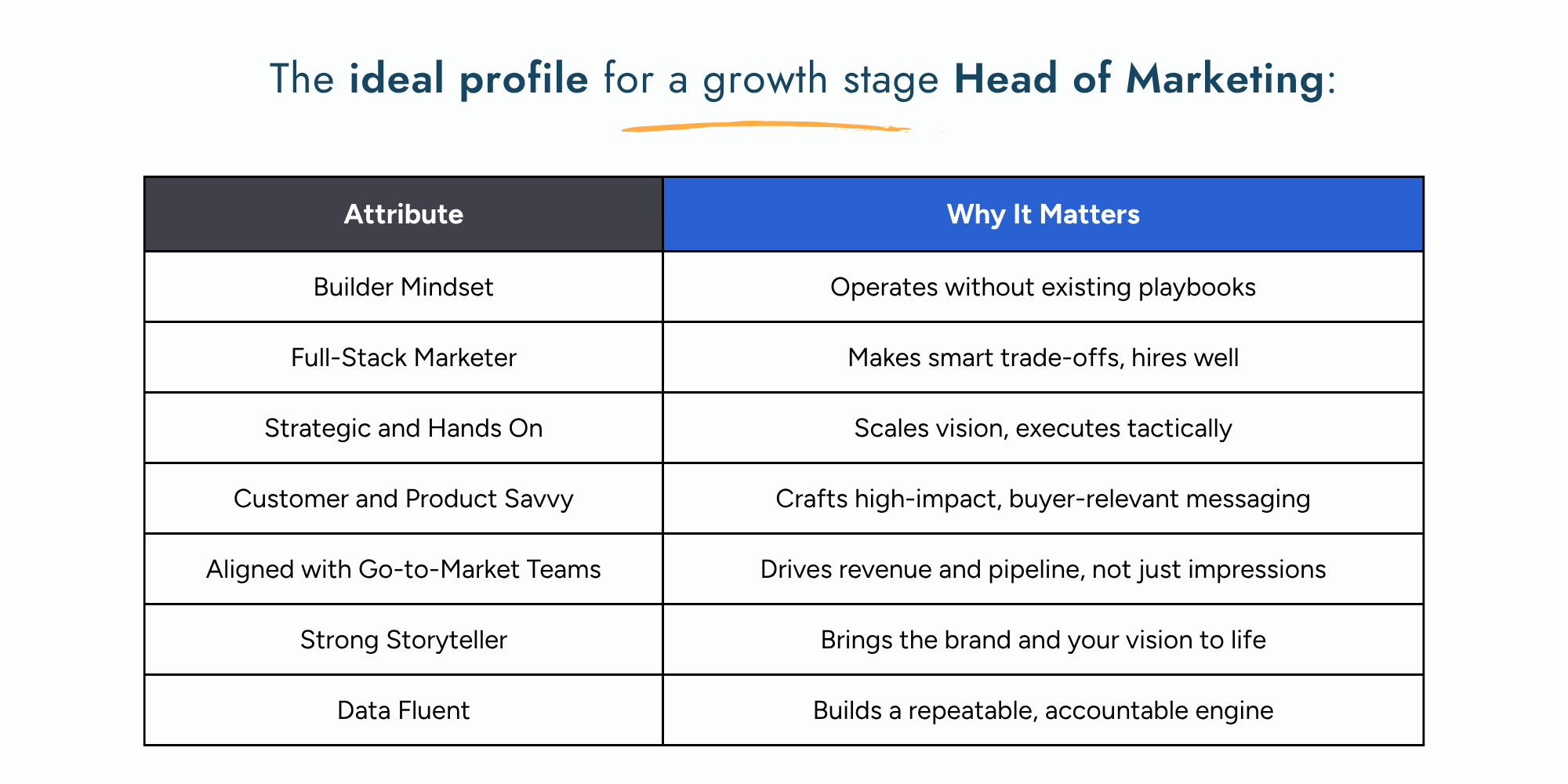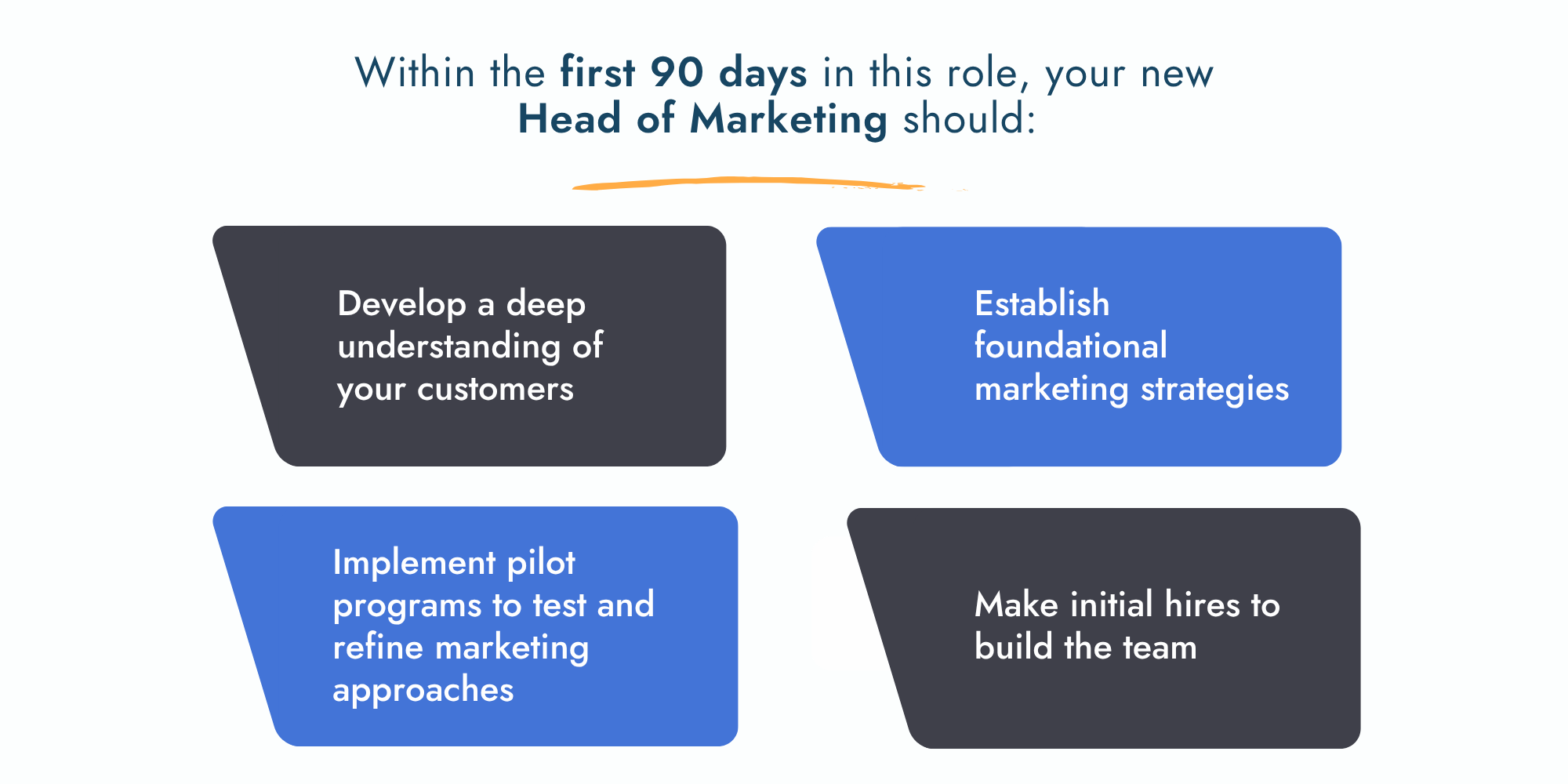This is part of Mainsail’s How-to-Hire Series: A SaaS Founder’s Guide to Building Out Your Leadership Team. Read why we put together this resource for growing SaaS businesses and how to navigate it here.
Hiring your first Head of Marketing is a strategic leap that goes beyond filling a function. For founder-led software companies, this person helps translate the founder’s vision into clear messaging, scalable demand, and a credible brand. They create a repeatable narrative that resonates externally and equips Sales and Customer Success with the tools to close and retain customers.
At Mainsail, we’ve helped many portfolio companies scale up with the hire of their first marketing leader. Here’s what we’ve learned about timing, what to look for, and how to set your new leader up for success.
When to hire your first Head of Marketing
Getting the timing right for when you hire a marketing leader can help unlock the next phase for growth for your company. Here are some key indicators it’s time to invest in a Head of Marketing:
- As the founder, you’re getting pulled in too many go-to-market (GTM) directions. If you’re writing product updates, investor decks and website copy, and your messaging and outreach is inconsistent and reactive, then you need someone to own marketing so you can get back to running the business.
- You’ve proven Product – Market Fit and need repeatable growth. If you’re seeing steady acquisition through your network and referrals, noticing growing interest without a way to capture demand, or finding leads and pipeline growth aren’t keeping up with product momentum, it’s time to professionalize your GTM efforts with a dedicated leader.
- Your story isn’t resonating at scale. If you hear “I don’t understand what you do,” or “you sound like every other company” or “your website doesn’t reflect how good this product really is,” you need someone who can craft and scale your narrative.
- You’re getting outpaced by the competition. If you’re burning time with disconnected freelancers, agencies, and interns, and can’t tie results to revenue, you need a strategic leader to orchestrate and optimize across channels.
- You’re preparing to unlock new markets or buyers. If you’re considering opening a new part of the market, evaluating adjacent markets, launching new products or building outbound motions, you need Marketing to drive both buzz and pipeline predictability.
Recognize the tipping point: It’s time to bring on a Head of Marketing when the cost of not having one outweighs the cost of hiring one. If your growth is slowing, your messaging lacks clarity, your sales motion is inefficient, or your go-to-market efforts aren’t scaling—chances are, you’ve already reached that point.
As a final test, ask yourself:
- Do I have a clear marketing strategy that’s working, or am I guessing?
- Can I quantify how marketing impacts revenue?
- Do I have time and expertise to build and manage this function myself?
If you answered no to any of these, you’re likely past due.
Define the leadership profile that will best fit this role
The marketing leader role isn’t a one-size-fits-all, especially for early-stage software businesses. The wrong profile can lead to lost time, wasted budget, and missed growth targets, but the right one can be transformative.

You will likely be evaluating between two titles: CMO/VP versus Director of Marketing. Understanding the differences can help you determine which experience level is best for your business.
CMO/VP of Marketing Profile:
- 10+ years of marketing experience
- Combines strategic vision with hands-on execution
- Aligns marketing efforts with business goals
- Navigates the challenges of scaling teams, and brings experience across all marketing programs (demand gen, product marketing, customer marketing, PR and communications, event marketing, etc.)
- Operates with a player/coach mentality
- Comfortable setting strategic direction and build relationships with boards and investors
- Willing to roll up their sleeves to drive initiatives forward
Director of Marketing Profile:
- 5-10 years of marketing experience
- Deep experience in one key area of marketing
- Experience managing small teams
- Strong tactical and execution skills
- Eager to prove themselves and grow
- May need coaching in board communication, budgeting and managing executive team dynamics
Characteristics to look for and how to evaluate
Once you’ve determined the level of marketing leader you need (Director vs. CMO/VP), the next step is to identify the characteristics that will help them thrive in your culture and create a plan to evaluate those traits during the hiring process.
When recruiting, aim for a strategic thinker with executional rigor– someone who has worked in scrappy environments, can build a strategy, and knows how to bring it to life. Prioritize candidates who have owned full-funnel marketing plans and metrics and have aligned marketing attribution to pipeline and revenue goals.
Ask in an interview:
“Walk me through your approach to building a marketing function from the ground up at a company like ours.”
Why it matters: This reveals how they balance brand, demand gen, and product marketing, and tailor strategy to your stage of growth, market and goals. Look for clear sequencing, resourcefulness, and comfort with ambiguity.
“Share with me a recent campaign launch or GTM motion that significantly impacted revenue or pipeline. What was your role, what worked, what did you learn?”
Why it matters: This evaluates their GTM collaboration and execution skills. Look for clear ownership, willingness to experiment, data-driven thinking and creativity.
Your Head of Marketing should demonstrate a comprehensive understanding of the marketing trifecta: Brand, Demand Generation, and Product Marketing. While specialization in one area is common, strong marketing leaders can balance all three, or at least recognize their interplay, understand where their own strengths lean and how to build around any gaps.
“Which part of the marketing trifecta is your strongest? Which one would you hire or outsource first, and why?”
Why it matters: This gives you a sense of their self-awareness and leadership maturity. Look for honest, confident answers, smart prioritization and experience with hiring or managing external partners.
Google AI Overviews are disrupting search marketing. Learn more about how to navigate this new paradigm >>Navigating AI Search: How to Adapt from Traditional to Zero-Click SEO
Additionally, align the background and experience target with your sales model. Don’t hire the person who has only sold six-figure enterprise deals to lead your product-led-growth freemium motion, or vice versa.
Your marketing leader should be data-driven, but that’s really just table stakes. Look for someone who focuses on outcomes, not just outputs. Ensure they have familiarity beyond “cost per” metrics and they understand the full buyer lifecycle, using ROI and efficiency metrics like Payback Period, Magic Number and LTV/CAC when evaluating their marketing investments.
It’s critical that your Head of Marketing has experience in automation and reporting tools such as HubSpot and Google Analytics. As of late, it is becoming imperative your leaders are also AI-literate.
“How are you using AI to make a measurable impact across your function?”
Why it matters: You’re looking for curiosity, practical examples and a clear sense of when and how to use AI for speed, efficiency and personalization across the marketing team and program efforts.
One final tip: don’t get hung up on industry-specific experience. Industry knowledge alone doesn’t make a great marketer, and an experienced marketer can learn even the most niche industry quickly. Always prioritize marketing expertise over industry familiarity.
Clarify the expectations of the role
Setting clear expectations is one of the most important things you can do to set up your new Head of Marketing (and your company) for success. Misalignment is the #1 reason these hires fail, especially in early-stage SaaS companies where the roles are fluid, and the pace is fast.
Before the candidate joins, align with your leadership team on what success looks like 30-60-90 days in, discuss the ownership expectations, potential shifts in influence, and a reporting structure that supports your goals.
Within the first 90 days, your new marketing leader should develop a deep understanding of the customer, establish foundational marketing strategies, make initial hires to build the team and implement pilot programs to test and refine marketing approaches. Maintain close alignment during this time to review progress against expectations, reprioritize based on learnings and catch misalignment early.
By the end of this period, you should see quantifiable – not just qualitative – improvements in pipeline generation and conversion rates.

Setting up your Head of Marketing for success
Hiring the right Head of Marketing is critical for growth. Align internally on the role’s purpose, define success for the first 90 days, and set clear expectations around ownership, resources, and priorities. Look for a strategic builder who can scale your vision while executing hands-on. With aligned goals and open communication, you’ll build a high-impact partnership that accelerates your company’s growth and builds lasting value.
UP NEXT: How to Hire a Head of Customer Experience⇒


